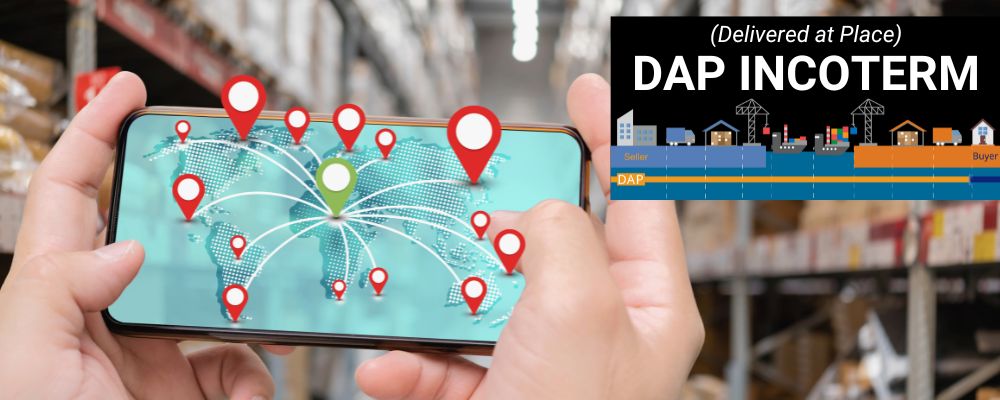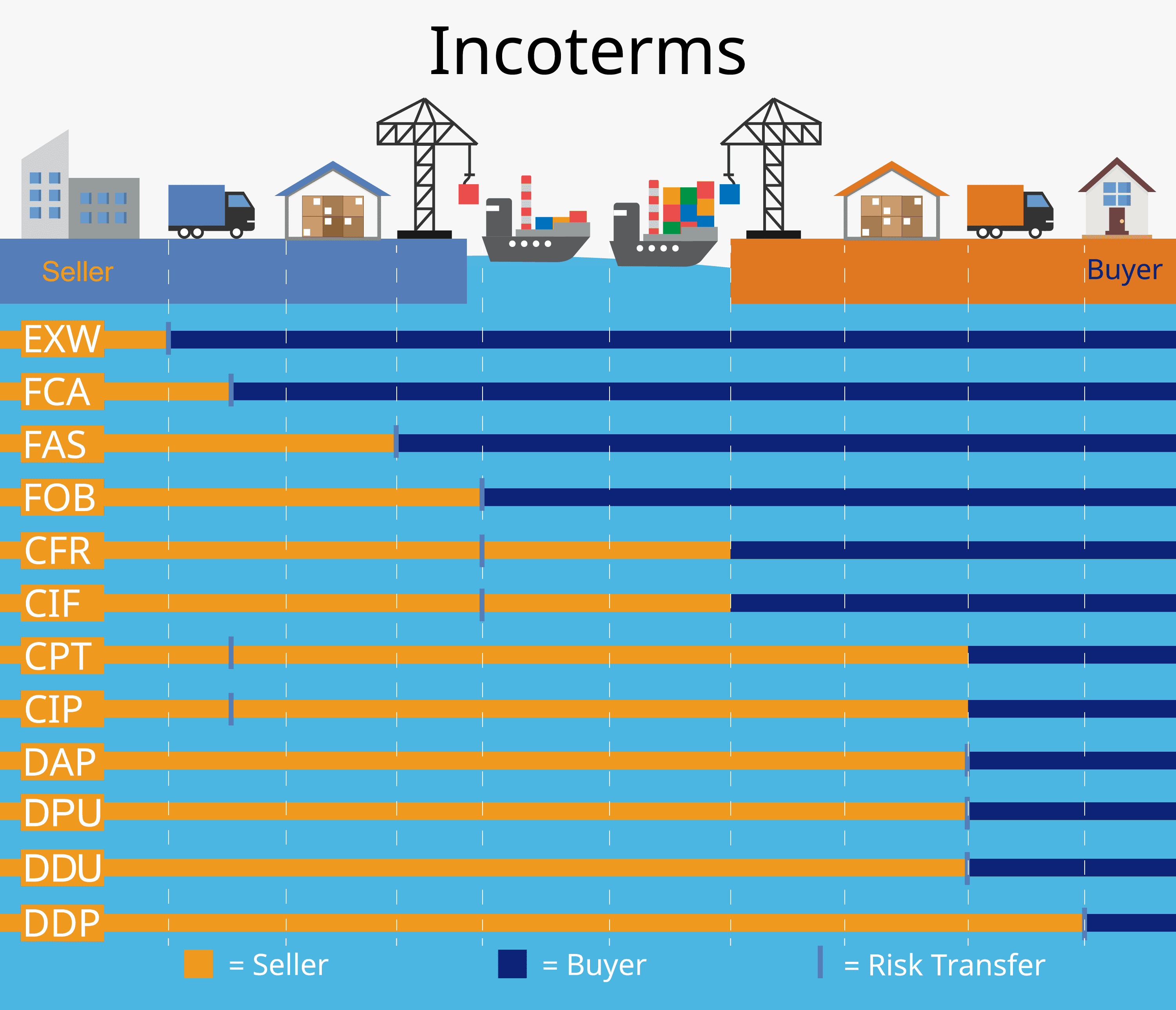
Introduction to DAP Incoterm
If you’re involved in buying or selling goods across borders, then you’ve probably come across various Incoterms. These are internationally recognized terms that define the responsibilities and liabilities between buyers and sellers when it comes to shipping and delivery.
In this blog post, we’ll be shedding light on one specific Incoterm – DAP, which stands for Delivered at Place. Whether you’re a seasoned trader looking to expand your knowledge or a newbie trying to navigate the complexities of global commerce, understanding the ins and outs of DAP will undoubtedly prove beneficial.
So grab a cup of coffee (or tea!) as we dive into what DAP Incoterm is all about. Let’s unravel its key features, compare it with other popular Incoterms like CIF and FOB, debunk some misconceptions, and explore real-life scenarios where using DAP can work wonders for your business. Are you ready? Let’s go!
Key features and responsibilities of seller and buyer under DAP
Under the DAP Incoterm, both the seller and buyer have specific responsibilities that they must fulfill. Let’s take a closer look at the key features and obligations of each party.
Seller: The seller is responsible for delivering the goods to the agreed-upon destination, which may be a terminal, warehouse, or even the buyer’s premises. They must ensure that the goods are packaged appropriately for transportation and handle all necessary export documentation.
Buyer: The buyer’s main responsibility is to receive and unload the goods once they arrive at their designated location. They must also cover any costs related to import customs clearance and taxes. Additionally, it is important for buyers to communicate with sellers regarding delivery details and any potential issues that may arise during transit.
Both parties should maintain good communication throughout the process to ensure smooth logistics operations. The DAP Incoterm allows flexibility in terms of transportation methods chosen by either party as long as it aligns with delivering at a specified place.
By clearly outlining these responsibilities, DAP helps establish clear expectations between buyers and sellers, minimizing misunderstandings or disputes along the way.
Benefits and drawbacks of using DAP Incoterm
Using the Delivered at Place (DAP) Incoterm can offer several advantages for both the seller and the buyer involved in international trade. One of the main benefits is that it provides more flexibility in terms of transportation arrangements. Under DAP, the seller is responsible for delivering goods to a specific location chosen by the buyer. This means that buyers have more control over where they want their goods to be delivered.
Another advantage of using DAP is that it simplifies customs procedures. The seller takes on the responsibility for export clearance, while the buyer handles import clearance. This division of responsibilities can help streamline customs processes and reduce potential delays or complications.
Additionally, using DAP can minimize financial risks for both parties. The seller bears most of the costs and risks associated with transporting goods until they are delivered to the agreed-upon place. This can provide peace of mind for buyers who may not have as much experience or resources when it comes to logistics and transportation.
However, there are also some drawbacks to consider when using DAP Incoterm. One potential disadvantage is that disputes may arise regarding delivery locations or conditions if they are not clearly specified in the contract between both parties. It’s important for sellers and buyers to communicate effectively and ensure all details are agreed upon upfront to avoid any misunderstandings.
Furthermore, since DAP transfers risk from sellers to buyers at an earlier stage compared to other incoterms like CIF or FOB, buyers need to be prepared financially and logistically to handle any unforeseen events or additional costs once goods reach their designated location.
While there are clear benefits associated with using DAP Incoterm such as increased flexibility and simplified customs procedures, it’s crucial for both parties involved in a transaction under this term to carefully negotiate and define all aspects related to delivery locations, conditions, and risk management beforehand
Comparison with other Incoterms, such as CIF and FOB
When it comes to international trade, understanding the various Incoterms is crucial for both buyers and sellers. Two commonly used terms that are often compared with DAP (Delivered at Place) are CIF (Cost, Insurance, and Freight) and FOB (Free on Board). Let’s take a closer look at how these three Incoterms differ from each other.
CIF is typically used in maritime transport, where the seller takes responsibility for delivering the goods to the port of destination. The seller also arranges and pays for insurance coverage until the goods reach this point. On the other hand, FOB applies mainly to ocean freight shipments as well but places more responsibility on the buyer. In this case, once the goods are loaded onto a vessel at the port of origin, ownership and risk transfer to the buyer.
In comparison, DAP offers more flexibility as it allows delivery anywhere agreed upon by both parties within an agreed-upon place or location. Unlike CIF or FOB which primarily focus on shipping terms between specific ports, DAP can be utilized for land transportation as well.
While all three Incoterms have their advantages depending on specific circumstances such as cost allocation or control over logistics processes; businesses must carefully consider their needs before choosing one over another.
Stay tuned for our next blog section where we will address common misconceptions about using DAP Incoterm!

Common misconceptions about DAP Incoterm
1. Lack of Control: One common misconception about using the DAP Incoterm is that the buyer has little control over the shipment. This is not true. While the seller is responsible for arranging transportation and delivery, the buyer still has a say in selecting their preferred carrier and negotiating terms with the seller.
2. High Costs: Some believe that opting for DAP means higher costs due to added responsibilities for the seller, such as customs clearance or import duties. However, it’s important to note that these costs are typically included in the overall price negotiated between both parties.
3. Limited Risk Management: Another misconception is that using DAP leaves buyers vulnerable to risks during transit since they have less visibility and control over their goods. However, with proper communication and documentation between buyer and seller, risk management can be effectively addressed even under DAP terms.
4. No Insurance Coverage: Contrary to popular belief, sellers can still provide insurance coverage for goods transported under DAP Incoterm if agreed upon beforehand in negotiations.
5. No Flexibility: Some may assume that once they agree on using DAP, there is no room for flexibility or adjustments along the way. However, like any other Incoterm, both parties can negotiate additional clauses or changes to suit their specific needs.
It’s essential to dispel these misconceptions surrounding DAP Incoterm so that businesses can make informed decisions when choosing their preferred trading method.
Examples of situations where using DAP is most suitable
Examples of situations where using DAP Incoterm is most suitable can vary depending on the specific circumstances of each transaction. However, there are some common scenarios where DAP can be a beneficial choice for both sellers and buyers.
For instance, if you are a seller who wants to expand into new international markets but do not have a physical presence or distribution network in those countries, using DAP can allow you to deliver goods directly to your customers’ specified location. This means that you don’t need to invest in establishing warehouses or hiring local distributors, saving time and resources.
Similarly, as a buyer importing goods from overseas suppliers, using DAP can offer more control and visibility over the shipping process. You can specify the delivery location according to your needs and preferences. This flexibility allows you to plan your inventory management efficiently and ensure timely delivery of products without relying on third-party logistics providers.
Moreover, in industries with complex supply chains involving multiple intermediaries or transshipment points, choosing DAP as the Incoterm can simplify logistics operations. By specifying the exact place of delivery under DAP terms, potential delays or additional costs associated with multiple transfers between carriers or customs authorities can be avoided.
In addition, businesses dealing with perishable goods like fresh produce or temperature-sensitive pharmaceuticals may find DAP advantageous. With this Incoterm, sellers have greater responsibility for ensuring proper handling and transportation conditions until reaching the agreed destination point. Thus, buyers receive goods in optimal condition while minimizing risks associated with transport-related spoilage.
These examples illustrate how using DAP Incoterm offers flexibility and control over logistics processes while reducing costs and risks for both sellers and buyers alike. By understanding these situational benefits along with its key features discussed earlier in this article will enable companies involved in international trade to make informed decisions when selecting an appropriate Incoterm for their specific needs.
Understanding the DAP Incoterm is crucial for businesses involved in international trade. This term provides clarity and accountability for both sellers and buyers, ensuring a smooth delivery process. By clearly defining responsibilities, the DAP Incoterm eliminates confusion and minimizes risks.
Key features of the DAP Incoterm include the seller’s responsibility for delivering goods to an agreed-upon place, while the buyer takes care of unloading. This term offers flexibility as it can be used for any mode of transportation. However, it is important to note that insurance coverage is not included under DAP, so buyers should consider obtaining their own coverage.
When comparing with other popular Incoterms such as CIF and FOB, DAP stands out due to its simplicity and transparency in terms of costs and responsibilities. It allows more control over shipping arrangements compared to CIF but may require additional effort from buyers compared to FOB.
It’s essential to address common misconceptions about DAP. Some believe that it includes customs clearance or covers all transport-related costs; however, these are separate obligations that need careful consideration when using this term.
DAP is most suitable when both parties want a balance between cost-sharing and risk management. It works well when there are established routes with reliable logistics partners or when there is no clear distinction on who should arrange carriage or insurance.
The DAP Incoterm streamlines international trade by establishing clear guidelines for sellers and buyers regarding delivery obligations. Its simplicity makes it attractive for many businesses engaged in global transactions. When properly understood and applied, this term ensures smoother operations while minimizing potential disputes or misunderstandings along the supply chain.
Remembering that each situation requires careful evaluation before deciding on which Incoterm best suits your business needs will lead you towards successful trading ventures worldwide.

